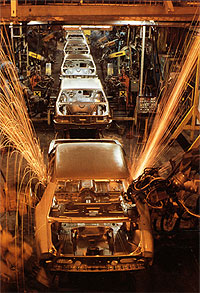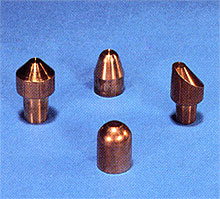High-Tech Copper Electrodes Help Cadillac Win Award
Resistance spot welding with cap electrodes made of GlidCop, a trademarked name for dispersion strengthened copper, played a key role for GMC's Cadillac Motor Car Division in winning the 1990 Malcolm Baldrige National Quality Award Competition for manufacturing.
 GMC's Cadillac assembly line using Nippert cap electrodes made from SCM's GlidCop for robotically-applied resistance spot welding
GMC's Cadillac assembly line using Nippert cap electrodes made from SCM's GlidCop for robotically-applied resistance spot welding Photo courtecy of Sacks
GlidCop is manufactured by SCM Metal Products, Inc., a major producer of metal powders and the world's leader in dispersion strengthened copper technology. The cap electrodes used by Cadillac were made by The Nippert Company of Delaware, Ohio, from dispersion strengthened copper (C15760) supplied in rod form by SCM Metal Products, headquartered in Research Triangle Park, North Carolina.
According to William Sarwas, a Cadillac manufacturing engineer at the Detroit-Hamtramck Assembly Center, the Nippert caps are snug-fitted onto resistance welding electrode shanks. The caps are used to aid the welding of coated steels - some 2,700 resistance spot welds per car, of which 1,900 are applied robotically.
"We've tried other cap electrodes," Sarwas said, "But they're not as durable and forgiving in a metal application situation and do not produce as good a weld."
A weld verification coordinator for Cadillac reports that with the use of the Nippert caps the mean average of good welds increased one full percentage point, from 96.8 percent in December 1988 to 97.8 percent during the Summer of 1990.
More than 167,000 companies requested applications for the 1990 Baldrige Award, but only 97 completed the rigorous procedure established by the U.S. Department of Commerce. Of those 97, only six made it to the finals where four winners were then chosen.
Cadillac was the only manufacturering contestant engaged in welding production. Quality improvements at Cadillac have led to a 30 percent reduction in warranty costs.
Nippert Cap Electrodes
In addition to the auto industry, Nippert sells cap electrodes to appliance manufacturers and metal fabricators for use in hand-held or robotic welding equipment.
Nitrode and Cupal are Nippert trademarks for cap electrodes made of SCM's GlidCop. Nitrode provides for no-stick welding of galvanized steel and other coated metals without special dressing or pastes - conductive elements enhancing current carrying capacity.
"Nitrode is the most cost-effective cap electrode for the resistance welding of heavy-gauge coated and uncoated steels," according to Russell A. Nippert, the company's president and general manager.
Cold-formed from dispersion strengthened copper, Nitrode lasts up to six times longer than Class 2 electrodes. "In some cases, Nitrode has delivered ten times the service life of Class 2," Nippert claims. Class 2 electrodes are those that can withstand high current levels without sticking.
"Nitrode requires 10 percent less power than Class 2 electrodes. It also resists 'mushrooming,' meaning growth of the contact area caused by heat, and it reduces maintenance time," Nippert says.
Nippert says, "If you want to spend more time welding and less time maintaining electrodes, then buy Nitrode."
Nitrode is available in 1/2-, 5/8- and 3/4-inch sizes for all cap-adaptive, water-cooled resistance welding equipment.
The Nippert Company is a subsidiary of Outokumpu Copper OY, Helsinki, Finland. Established in 1947, Nippert does about 50 percent of its sales in cap electrodes for welding equipment - two-thirds of which are made of GlidCop disper- sion strengthened copper.
Nippert describes itself as a full-service copper producer and supplier offering copper rod and wire, copper strip, copper anode "balls" or large pellets, for the plating industry, and extruded components for the electronic industry.
SCM Produces Glidcop
 Nippert electrodes made from GlidCop
Nippert electrodes made from GlidCopGlidCop is one of a family of dispersion strengthened coppers introduced by SCM Metal Products in 1973, and sold as rod, strip, wire, plate, tube and other shapes.
GlidCop products are made by the internal oxidation technique. The patented process begins with melting a dilute solid solution alloy of copper and aluminum. The melt is atomized into powder, and heated under oxidizing conditions.
At this point, the aluminum in the alloy is selectively oxidized in-situ, explains Gordon L. Johnson, vice president of market development for GlidCop.
Following this, the powder is consolidated into fully dense shapes by one of several conventional metal- working processes. The shapes are further changed by drawing, rolling or other means. The cold-working done after consolidation significantly increases the strength of GlidCop products.
Johnson says, welding one galvanized sheet to another is the basic joining process in auto and truck manufacturing. This operation was often difficult before GlidCop was introduced because of the frequent sticking of the electrodes to the sheet metal, "but when the electrodes were made of GlidCop, there was no sticking," according to Johnson.
Today, Johnson says, there can be as many as 5,000 spot welds per vehicle, so trouble-free welding is very important.
GlidCop is marketed throughout the world and has gained wide acceptance in a variety of demanding applications, such as: resistance welding electrodes, seam welding wheels, incandescent lamp leads, relay blades and contact supports, integrated circuit lead frames, and hybrid circuit packages, Johnson reports.Also in this Issue:
- Biosphere 2 Uses Miles of Copper Tube and Wire
- High-Tech Copper Electrodes Help Cadillac Win Award
- Home of Future - Aglow with Copper and Brass
- Rigidized Metals Corp. Grows with Textured Copper Metals
- Copper Roofing Study Completed
- CDA Offers New Software for Bronze Bearing, Bushing Design
- DecoShield for Fire Sprinklers
- Copper Sculpture Baffles CIA
- Copper Consumer Products Draw Attention, Grow in Sales
